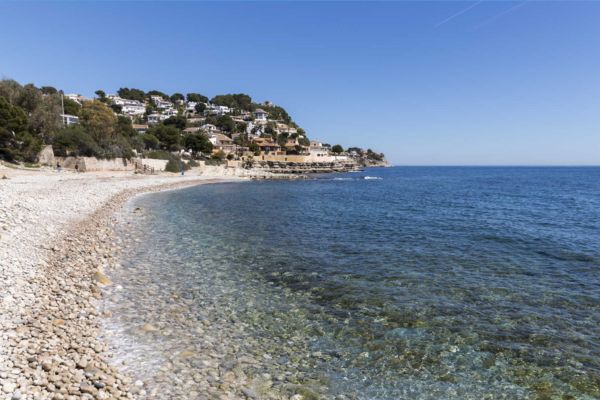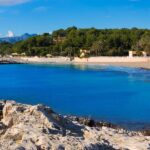Benissa, a hidden treasure on the Costa Blanca, offers more than just idyllic beaches — it hides one of the most scenic walking routes in Spain: the Benissa Ecological Coastal Trail. Whether you’re staying in a seaside villa or visiting for the day, this trail is a must for nature lovers, photographers, and families alike.
This 4.5 km trail follows the rugged coastline between Les Bassetes and Cala del Baladrar, passing secluded coves, dramatic cliffs, and Mediterranean pine forests. It’s perfect for slow travel, sunrise or sunset walks, and even as a half-day microadventure from Moraira or Calpe.

Why Walk the Benissa Coastal Trail?
This eco-trail winds through cliffs, pine groves, and coves with crystalline waters. Along the way, you’ll discover five unique beaches, Mediterranean flora, and breathtaking viewpoints. Interpretative signs share local history, geology, and fauna — enriching the experience. It’s accessible year-round and has several entry points — perfect for short or full-day hikes.
The trail promotes sustainable tourism, as it’s protected from overdevelopment. You won’t find high-rise buildings here — only the sounds of waves, birds, and the occasional kayaker.
🗺️ Trail Overview
Distance: 4.5 km (one way)
Duration: 2–3 hours (with stops)
Difficulty: Easy to moderate
Surface: Natural paths, wooden boardwalks, some rocky areas
Start Point: Cala del Baladrar
End Point: Cala de la Fustera (or vice versa)
1. Cala del Baladrar
Start your journey on smooth pebbles, framed by jagged rocks and pine trees. Baladrar is famous for its sunset views and beach bar (chiringuito) open in summer. The flat rocks make it a popular spot for yoga or early-morning meditation.
Photo Tip: Capture the iconic rock arch with the Peñón de Ifach in the background. At low tide, tidal pools form ideal for macro photography.
Nearby: Easy parking and a summer-only bar offering drinks and light bites.
2. Cala Advocat
A peaceful bay with a small jetty and shallow waters, great for children and snorkeling. There’s a narrow trail along the cliff with rest areas and benches, making it a scenic picnic spot.
Local Tip: Bring snorkeling gear — the rocky seabed is full of marine life like wrasse and sea bream.
For Cyclists: There’s bike parking nearby, and this area connects with inland cycling routes.

3. Cala Llobella
Benissa’s wildest and least-developed cove. Surrounded by steep cliffs and pine forest, it’s accessible only by foot. Pure Mediterranean silence, with rougher access that discourages large crowds.
Caution: No services here — pack water and good shoes. Ideal for experienced walkers or photographers.
Geology Fans: Check out the exposed fossil layers in the cliffs.
4. Cala Pinets
A small sandy inlet with clear turquoise waters. A natural pool-like space makes it ideal for swimming with kids. To the right, a rocky path leads to the “Mar Morta i Roques Negres” — a unique formation where the sea appears still like a lagoon.
Explorer Bonus: The black rocks contrast beautifully with the sea’s turquoise hue — ideal for drone shots.
Accessibility Note: Partial access for reduced mobility visitors via a boardwalk.
5. Cala de la Fustera
Finish at this Blue Flag beach with fine sand, a beach bar, sunbeds, and a small ecological center. From here, there are links to trails toward Calpe or the Sierra de Bernia. It’s the most developed cove but retains a natural feel thanks to vegetation buffers.
Facilities: Parking, restrooms, showers, lifeguards (in summer), accessible path.
Bonus: Visit the nearby “Casa dels Cents Vents”, a modernist villa now used for exhibitions.
🌿 Nature & Interpretation
Along the route, you’ll find informative signs about:
Mediterranean biodiversity (e.g. junipers, rosemary, thyme)
Birdwatching: kestrels, swifts, seabirds
Geology: limestone cliffs, erosion patterns, fossil sites
Marine life: fish species, Posidonia oceanica meadows (underwater)
🥾 What to Bring
Comfortable walking shoes or trail sandals
Water (at least 1 liter per person)
Snacks or a light picnic
Sun protection (hat, sunscreen, sunglasses)
Swimwear, towel, snorkel mask
Phone or camera with full battery
Optional: binoculars for birdwatching, reusable bags for waste
📍 How to Get There
Benissa’s coves are accessible by car from Moraira, Calpe or Benissa town (10–15 mins). Buses from Benissa also serve the coast. If you’re staying with VamDays, ask about nearby properties with trail access.
Where to Stay Near the Trail
VamDays offers a curated selection of holiday villas and apartments close to the coastal trail. Choose from:
Sea-view apartments at Cala Pinets
Private villas near Cala Baladrar with pool
Family homes walking distance from La Fustera
Whether you’re seeking romance, relaxation, or outdoor adventure, we’ll help you find the perfect stay.
🍽️ Eat & Drink Along the Trail
Chiringuito Baladrar – beach snacks and live music on weekends
Mandala Beach Bar (La Fustera) – cocktails, tapas, and sea views
Restaurante Pedramala – for a post-walk meal with panoramic views (short drive inland)
📆 When to Go
Spring (March–May): Flowers bloom, perfect hiking weather
Summer (June–Aug): Best for swimming, but go early to avoid heat
Autumn (Sept–Nov): Warm seas, fewer crowds
Winter (Dec–Feb): Crisp air, ideal for walking without swimming
FAQs
Is the trail suitable for kids? Yes, though Llobella has uneven terrain. Most sections are stroller-friendly with supervision.
Are dogs allowed? Yes, on a leash. Some beaches allow dogs in off-peak seasons.
Can I park nearby? Yes, there’s parking near each cove. Arrive early in summer.
When’s the best time to walk it? Spring and autumn offer ideal temperatures and fewer crowds.
Can I do it in reverse? Absolutely. Start at La Fustera and end at Baladrar if staying closer to Calpe.
Is it accessible for wheelchairs? Partially — Fustera has boardwalks, but most coves are natural paths.






